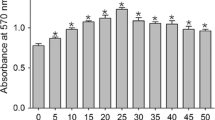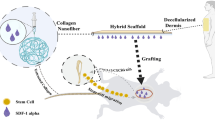Abstract
One of the key objectives of regenerative medicine is the design of skin tissue engineering scaffolds to promote wound healing. These scaffolds provide a fresh viewpoint on skin injury repair by emulating body tissues in their structure. A suitable platform for cellular processes can be provided by natural scaffolds made from decellularized tissues while retaining the primary components. Resveratrol (RES), which has qualities like angiogenesis, antioxidant, antibacterial, and anti-inflammatory, is also useful in the healing of wounds. In this investigation, RES-loaded decellularized sheep pericardium scaffolds were created and tested on full-thickness wounds in a mouse model. According to the in vivo findings, the groups in which the wound was treated with decellularized pericardium (DP) had better wound healing than the control group and showed more production of angiogenic and anti-inflammatory substances. The secretion of these factors was greater in RES‐loaded decellularized pericardium (DP-RES) than in the scaffold without RES, and the macroscopic and histological data supported this. Therefore, the use of decellularization scaffolds with substances like RES for the regeneration of skin wounds can be further researched and evaluated in the preclinical stages.





Similar content being viewed by others
Data availability
The datasets generated during and/or analyzed in this study are available from the corresponding author upon reasonable request.
References
Alizadeh A, Rezakhani L, Shoa MA, Ghasemi S (2020a) Frequency of CD44 positive cells in MKN45 cell line after treatment with docetaxel in two and three-dimensional cell cultures. Tissue Cell 63:101324
Alizadeh M, Rezakhani L, Alizadeh A (2020b) Characterization of the decellularized ovine pericardium for skin tissue engineering. J Shahrekord Univ Med Sci 22:173–180
Alizadeh M, Rezakhani L, Khodaei M, Soleimannejad M, Alizadeh A (2021) Evaluating the effects of vacuum on the microstructure and biocompatibility of bovine decellularized pericardium. J Tissue Eng Regen Med 15:116–128
Alizadeh M, Rezakhani L, Nooshabadi VT, Alizadeh A (2022) The effect of Scrophularia striata on cell attachment and biocompatibility of decellularized bovine pericardia. Cell Tissue Banking 23:261–269
Asghari F, Faradonbeh DR, Malekshahi ZV, Nekounam H, Ghaemi B, Yousefpoor Y, Ghanbari H, Faridi-Majidi R (2022) Hybrid PCL/chitosan-PEO nanofibrous scaffolds incorporated with A euchroma extract for skin tissue engineering application. Carbohydr Polymers 278:118926
Baur JA, Sinclair DA (2006) Therapeutic potential of resveratrol: the in vivo evidence. Nat Rev Drug Discov 5:493–506
Bektas K, Cemile IK, Sendemir A, Hasirci V, Hasirci N (2018) A bilayer scaffold prepared from collagen and carboxymethyl cellulose for skin tissue engineering applications. J Biomater Sci Polym Ed 29:1764–1784
Bozorgi A, Haghighi Z, Khazaei MR, Bozorgi M, Khazaei M (2023) The anti-cancer effect of chitosan/resveratrol polymeric nanocomplex against triple-negative breast cancer; an in vitro assessment. IET Nanobiotechnol 17:91–102
Das S, Das DK (2007) Anti-inflammatory responses of resveratrol. Inflamm Allergy-Drug Targets Former Curr Drug Targets-Inflamm Allergy Discontinued 6:168–173
David S, Alfonso V, Güiza-Argüello VR, Arango-Rodríguez ML, Sossa CL, Becerra-Bayona SM (2022) Decellularized tissues for wound healing: Towards closing the gap between scaffold design and effective extracellular matrix remodeling. Front Bioeng Biotechnol 10:194
Del Bakhshayesh R, Azizeh NA, Khalilov R, Akbarzadeh A, Samiei M, Alizadeh E, Alizadeh-Ghodsi M, Davaran S, Montaseri A (2018) Recent advances on biomedical applications of scaffolds in wound healing and dermal tissue engineering. Artif Cells, Nanomed, Biotechnol 46:691–705
Ferrer RA, Saalbach A, Grünwedel M, Lohmann N, Forstreuter I, Saupe S, Wandel E, Simon JC, Franz S (2017) Dermal fibroblasts promote alternative macrophage activation improving impaired wound healing. J Investig Dermatol 137:941–950
Folkman J (2006) Angiogenesis. Annu Rev Med 57:1–18
Garvin S, Öllinger K, Dabrosin C (2006) Resveratrol induces apoptosis and inhibits angiogenesis in human breast cancer xenografts in vivo. Cancer Lett 231:113–122
Huang X, Sun J, Chen G, Niu C, Wang Y, Zhao C, Sun J, Huang H, Huang S, Liang Y (2019) Resveratrol promotes diabetic wound healing via SIRT1-FOXO1-c-Myc signaling pathway-mediated angiogenesis. Front Pharmacol 10:421
Javanmardi S, Safari I, Aghaz F, Khazaei M (2021) Wound healing activities of Gundelia tournefortii L extract and milk-cream ointment on second-degree burns of rat skin. Int J Low Extrem Wounds 20:272–281
Keshavarz G, Jalili C, Pazhouhi M, Khazaei M (2020) Resveratrol effect on adipose-derived stem cells differentiation to chondrocyte in three-dimensional culture. Adv Pharm Bull 10:88
Khazaei F, Rezakhani L, Alizadeh M, Mahdavian E, Khazaei M (2022) Exosomes and exosome-loaded scaffolds: Characterization and application in modern regenerative medicine. Tissue Cell. https://doi.org/10.1016/j.tice.2022.102007
Khoshnood N, Zamanian A (2020) Decellularized extracellular matrix bioinks and their application in skin tissue engineering. Bioprinting 20:e00095
Oliveira JR, Guimarães VHD, Pereira UA, Oliveira FR, Santos SHS (2022) The use of textiles in the wound healing: a review. Mini Rev Med Chem 22:1438–1449
Pandey S, Shamim A, Shaif M, Kushwaha P (2023) Development and evaluation of Resveratrol-loaded liposomes in hydrogel-based wound dressing for diabetic foot ulcer. Naunyn-Schmiedeberg’s Archiv Pharmacol 396:1811–1825
Pastore S, Lulli D, Fidanza P, Potapovich AI, Kostyuk VA, De Luca C, Mikhal’Chik E, Korkina LG (2012) Plant polyphenols regulate chemokine expression and tissue repair in human keratinocytes through interaction with cytoplasmic and nuclear components of epidermal growth factor receptor system. Antioxid Redox Signal 16:314–328
Rezakhani L, Sima S, Masoumeh ED and Sorayya G (2023). 'Resveratrol: Targeting cancer stem cells and ncRNAs to overcome cancer drug resistance', Current Molecular Medicine.
Rosenberg AS (2017) Reconsidering the H&E stain as the gold standard in assessing the depth of burn wounds. J Cutan Pathol 44:1049–1050
Sharifi E, Sadati SA, Yousefiasl S, Sartorius R, Zafari M, Rezakhani L, Alizadeh M, Zare EN, Omidghaemi S, Ghanavatinejad F (2022) Cell loaded hydrogel containing Ag-doped bioactive glass–ceramic nanoparticles as skin substitute: Antibacterial properties, immune response, and scarless cutaneous wound regeneration. Bioeng & Translat Med 7:e10386
Truong V-L, Jun M, Jeong W-S (2018) Role of resveratrol in regulation of cellular defense systems against oxidative stress. BioFactors 44:36–49
Yuan G, Wahlqvist ML, He G, Yang M, Li D (2006) Natural products and anti-inflammatory activity. Asia Pacific J Clin Nutr 15:143–152
Zhao P, Bing-Dong Sui Nu, Liu Y-J, Zheng C-X, Yong-Bo Lu, Huang W-T, Zhou C-H, Chen Ji, Pang D-L (2017) Anti-aging pharmacology in cutaneous wound healing: effects of metformin, resveratrol, and rapamycin by local application. Aging Cell 16:1083–1093
Acknowledgements
The authors would like to thank the Fertility and Infertility Research Center.
Funding
This paper was funded research deputy of Kermanshah University of Medical Sciences, Kermanshah, Iran.
Author information
Authors and Affiliations
Contributions
MK performed data measurement and statistical analysis. SR, MRK, LR performed the dissection experiments and wrote the first draft of the manuscript. MK. LR contributed to the conception and design of the study. All authors contributed to the manuscript revision, read, and approved the submitted version.
Corresponding author
Ethics declarations
Conflict of interest
No potential conflict of interest was reported by the authors.
Ethical approval
This study was accepted under the management of the Ethics Committee of Kermanshah University of Medical Sciences and with the ethics code IR.KUMS.AEC.1400.006.
Additional information
Publisher's Note
Springer Nature remains neutral with regard to jurisdictional claims in published maps and institutional affiliations.
Rights and permissions
Springer Nature or its licensor (e.g. a society or other partner) holds exclusive rights to this article under a publishing agreement with the author(s) or other rightsholder(s); author self-archiving of the accepted manuscript version of this article is solely governed by the terms of such publishing agreement and applicable law.
About this article
Cite this article
Khazaei, M., Rahmati, S., Khazaei, M.R. et al. Accelerated wound healing with resveratrol‐loaded decellularized pericardium in mice model. Cell Tissue Bank 25, 245–253 (2024). https://doi.org/10.1007/s10561-023-10117-w
Received:
Accepted:
Published:
Issue Date:
DOI: https://doi.org/10.1007/s10561-023-10117-w




